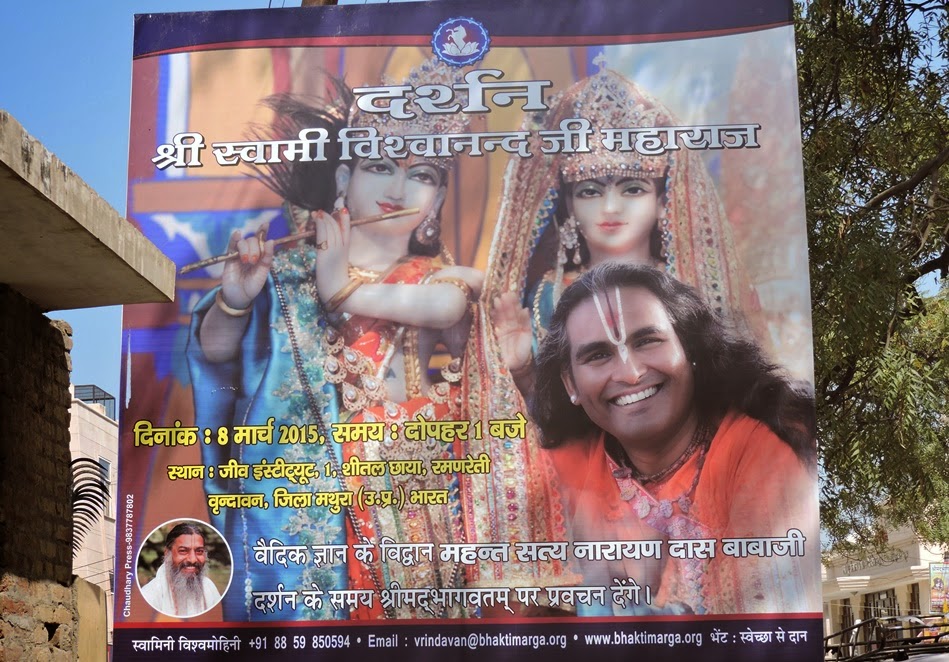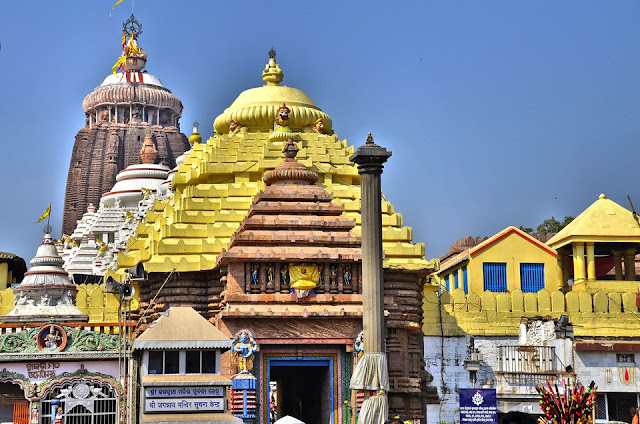Bhajana Rahasya (from introduction by B.P. Puri Maharaj)
I am going to post a bunch of translations. This is from the introduction to Bhajana Rahasya by B.P. Puri Maharaj.
=============
My heroic pastimes are very pleasing to the ear and satisfying to the heart when heard in the association of pure devotees. As a result of joyfully relishing these pastimes in such association, one quickly advances on the path of liberation, passing through the stages of faith (śraddhā), the revelation of one’s divine relationship with Krishna (rati), and true love for Him (bhakti). (Śrīmad-bhāgavatam 3.25.25)
Expanded translation: The mind finds joy in the Lord through association with saintly people. This verse explains the results of such association in their proper sequence. In fact, there is a preliminary stage of faith which comes after hearing that holy association should be sought out. When the neophyte finds superior association (prasaṅga), he gets the opportunity to hear about Krishna.
In other words, one may be able to engage in other devotional activities in inferior association, but there will be no elevated discussions of Krishna. The discussions in such superior association cause one’s anarthas to be eliminated and then lead to the development of firm resolve. At this point, one has a direct perception of My glories through this hearing.
This leads to ruchi, as implied in the words “pleasing to the ears and heart” (hṛt-karṇa-rasāyanāḥ kathāḥ), whereby one relishes the topics of Krishna with great affection. This is then followed on this path of liberation by faith, which here means attachment (äsakti), then rati, which means the preliminary stage of ecstasies, or bhäva, and bhakti, which here means prema. The system of devotional service I have established will spread through the world by this gradual process of development. (Vishwanath)
In this verse, but rati = bhāva, and yes, that is what is meant by bhāva. Bhāva means the capacity to experience rasa, which can only come when you are fixed in your spiritual identity.
"It is the age of Kali and the sense are powerful enemies. The divine path of devotion is covered with countless thorns and obstacles. Where can I take shelter? I am crippled, what can I do, O moon of Consciousness, Chaitanya Chandra, if you are not today merciful to me ?" (Caitanya-candrāmṛta 125)
The dhārā from Bhaktivinode Thakur is the stream of Nam Bhajan. For one in this line, everything, literally everything, is the fruit of the Holy Name, faith in the Name, and love for the Holy Name. No matter where you stand on the path of bhajan.
premera kalikā nāma adbhuta rasera dhāma
The Holy Name is a burgeoning flowerbud, the amazing abode of rasa. It manifests so much transcendental power. When it is even slightly revealed, it shows me its own spiritual form and attributes. It steals my mind and takes it into the presence of Krishna.
When the Name is fully revealed, it takes me directly to Vraja, where it shows me my personal role in the eternal pastimes. It bestows on me my eternal spiritual identity and form, places me by Krishna’s side and completely destroys [my identification with] this material body. (Kṛṣṇa nāma dhare kata bala, 6-7)
When one has jaundice, then sweets taste bitter on account of the increased bile in the system. The Holy Name is also sweet, but we are so affected by the beginningless ignorance and avoidance of our relationship of service to the Lord that it does not taste good to us. If however, we take up chanting the Holy Name and hearing about the Lord constantly and with faith, then we will gradually experience their transcendental taste with ever-increasing intensity, for the Holy Name itself treats our disease of ignorance. When the disease is completely eradicated, we enjoy Krishna bhajan completely. (Upadeśāmṛta 6, Translation in accordance with Srila Prabhupada’s Anuvritti)
When one has developed a full taste for Krishna bhajan, then he gets the good fortune of being able to follow Rupa Goswami’s next instruction, which he calls the essence of all advice:
One should follow the progressive path and engage the tongue, which is accustomed to speaking of other things but Krishna, and the mind, which is similarly accustomed to thinking of things other than Krishna, in attentively chanting His name, form, virtues and pastimes. When one’s taste for these things has manifested fully, he should take up residence in Vrindavan and, following in the footsteps of a senior devotee resident of the Dham and live out one’s days in hearing and chanting about Krishna, the son of Nanda. (Upadeśāmṛta 7)
=============
My heroic pastimes are very pleasing to the ear and satisfying to the heart when heard in the association of pure devotees. As a result of joyfully relishing these pastimes in such association, one quickly advances on the path of liberation, passing through the stages of faith (śraddhā), the revelation of one’s divine relationship with Krishna (rati), and true love for Him (bhakti). (Śrīmad-bhāgavatam 3.25.25)
satāṁ prasaṅgān mama vīrya-saṁvido
bhavanti hṛt-karṇa-rasāyanāḥ kathāḥ
taj-joṣaṇād āśv apavarga-vartmani
śraddhā ratir bhaktir anukramiṣyati
Expanded translation: The mind finds joy in the Lord through association with saintly people. This verse explains the results of such association in their proper sequence. In fact, there is a preliminary stage of faith which comes after hearing that holy association should be sought out. When the neophyte finds superior association (prasaṅga), he gets the opportunity to hear about Krishna.
In other words, one may be able to engage in other devotional activities in inferior association, but there will be no elevated discussions of Krishna. The discussions in such superior association cause one’s anarthas to be eliminated and then lead to the development of firm resolve. At this point, one has a direct perception of My glories through this hearing.
This leads to ruchi, as implied in the words “pleasing to the ears and heart” (hṛt-karṇa-rasāyanāḥ kathāḥ), whereby one relishes the topics of Krishna with great affection. This is then followed on this path of liberation by faith, which here means attachment (äsakti), then rati, which means the preliminary stage of ecstasies, or bhäva, and bhakti, which here means prema. The system of devotional service I have established will spread through the world by this gradual process of development. (Vishwanath)
In this verse, but rati = bhāva, and yes, that is what is meant by bhāva. Bhāva means the capacity to experience rasa, which can only come when you are fixed in your spiritual identity.
kālaḥ kalir balina indriya-vairi-vargāḥ
śrī-bhakti-mārga iha kaṇṭaka-koṭi-ruddhaḥ |
hā hā kva yāmi vikalaḥ kim ahaṁ karomi
caitanya-candra yadi nādya kṛpāṁ karoṣi ||
"It is the age of Kali and the sense are powerful enemies. The divine path of devotion is covered with countless thorns and obstacles. Where can I take shelter? I am crippled, what can I do, O moon of Consciousness, Chaitanya Chandra, if you are not today merciful to me ?" (Caitanya-candrāmṛta 125)
The dhārā from Bhaktivinode Thakur is the stream of Nam Bhajan. For one in this line, everything, literally everything, is the fruit of the Holy Name, faith in the Name, and love for the Holy Name. No matter where you stand on the path of bhajan.
premera kalikā nāma adbhuta rasera dhāma
hena bala karaye prakāśa |
īṣat vikaśita hañā dekhāya nija rūpa guṇa
citta hari laya kṛṣṇa pāśa ||6||
The Holy Name is a burgeoning flowerbud, the amazing abode of rasa. It manifests so much transcendental power. When it is even slightly revealed, it shows me its own spiritual form and attributes. It steals my mind and takes it into the presence of Krishna.
pūrṇa vikaśita hañā vraje more yāya lañā
dekhāya mora svarūpa vilāsa |
more siddha deha diyā kṛṣṇa pāśe rākhe giyā
e dehera kare sarvanāśa ||7||
When the Name is fully revealed, it takes me directly to Vraja, where it shows me my personal role in the eternal pastimes. It bestows on me my eternal spiritual identity and form, places me by Krishna’s side and completely destroys [my identification with] this material body. (Kṛṣṇa nāma dhare kata bala, 6-7)
syāt kṛṣṇa-nāma-caritādi-sitāpy avidyā-
pittopatapta-rasanasya na rocikā nu
kintv ādarād anudinaṁ khalu saiva juṣṭā
svādvī kramād bhavati tad-gada-mūla-hantrī
When one has jaundice, then sweets taste bitter on account of the increased bile in the system. The Holy Name is also sweet, but we are so affected by the beginningless ignorance and avoidance of our relationship of service to the Lord that it does not taste good to us. If however, we take up chanting the Holy Name and hearing about the Lord constantly and with faith, then we will gradually experience their transcendental taste with ever-increasing intensity, for the Holy Name itself treats our disease of ignorance. When the disease is completely eradicated, we enjoy Krishna bhajan completely. (Upadeśāmṛta 6, Translation in accordance with Srila Prabhupada’s Anuvritti)
When one has developed a full taste for Krishna bhajan, then he gets the good fortune of being able to follow Rupa Goswami’s next instruction, which he calls the essence of all advice:
tan-nāma-rūpa-caritādi-sukīrtanānu-
smṛtyoḥ krameṇa rasanā-manasī niyojya
tiṣṭhan vraje tad-anurāgi janānugāmī
kālaṁ nayed akhilam ity upadeśa-sāram
One should follow the progressive path and engage the tongue, which is accustomed to speaking of other things but Krishna, and the mind, which is similarly accustomed to thinking of things other than Krishna, in attentively chanting His name, form, virtues and pastimes. When one’s taste for these things has manifested fully, he should take up residence in Vrindavan and, following in the footsteps of a senior devotee resident of the Dham and live out one’s days in hearing and chanting about Krishna, the son of Nanda. (Upadeśāmṛta 7)



Comments